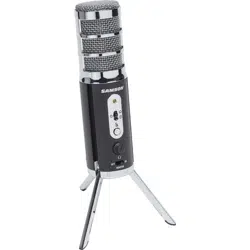Loading ...
Loading ...
Loading ...

Owner’s Manual 15
ENGLISHFRANÇAISDEUTSCHEESPAÑOLITALIANO
An important characteristic of any microphone is its
directionality or polar pattern. The Satellite feature dual 16mm
capsules, allowing for a choice of three distinct polar patterns:
omnidirectional, unidirectional (cardioid), and bidirectional
(figure-8). The microphone pattern can be selected using the
three-position slide switch on the front of the microphone. Each
pattern has distinct pick-up characteristics with respect to
the sensitivity and frequency response to sounds arriving from
different directions. The following section discusses some of the
features of each pattern, to help you choose the best setting for
your application.
Omnidirectional - The omnidirectional
setting reproduces sound from all directions,
(including off-axis), with an even frequency
response, which makes it resistant to the
phenomenon known as proximity effect. It
captures a greater amount of ambient sound
than the other settings, and thus will include
more of the room sound than when using
a directional setting. The omnidirectional
setting is great for recording ensemble performances including
group vocals, brass, woodwind, and other instruments with the
artists facing each other in a circle around the microphone.
Unidirectional (Cardioid) - The cardioid
pickup pattern is the most widely used
for studio and live miking applications. It
captures sound in front of the microphone
and rejects sound from the sides and
back, which allows for better separation
of instruments in the studio, and picks up
more of the instrument sound in relation
to the sound of the room. The separation
also allows for more control and more gain before feedback in live
sound reinforcement situations.
Bidirectional (Figure-8) - This setting
captures sound directly in front and back
of the microphone while rejecting sound on
the left and right sides, and has minimal
off-axis frequency response deterioration.
It is very useful in a variety of stereo
microphone techniques. The figure-8
pattern can be used to simultaneously
capture two instruments or vocalists by
positioning the microphone directly between them, so one is
addressing the front of the microphone and the other the rear.
About Polar Patterns
5
10
15
20
dB
25
45
45
90 90
135 135
180
0
5
10
15
20
dB
25
45
45
90 90
135 135
180
0
5
10
15
20
dB
25
45
45
90 90
135 135
180
0
Omnidirectional
Cardioid
Figure-8
Loading ...
Loading ...
Loading ...
